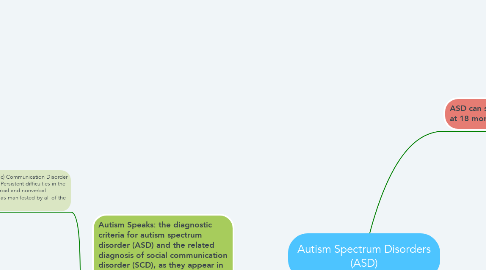
1. Autism Speaks: the diagnostic criteria for autism spectrum disorder (ASD) and the related diagnosis of social communication disorder (SCD), as they appear in the fifth edition of the Diagnostic and Statistical Manual of Mental Disorders (DSM-5). As of May 2013, psychologists and psychiatrists will be using these criteria when evaluating individuals for these developmental disorders.
1.1. Social (Pragmatic) Communication Disorder 315.39 (F80.89) Persistent difficulties in the social use of verbal and nonverbal communication as manifested by all of the following:
1.1.1. Deficits in using communication for social purposes, such as greeting and sharing information, in a manner that is appropriate for the social context.
1.1.2. Impairment of the ability to change communication to match context or the needs of the listener, such as speaking differently in a classroom than on the playground, talking differently to a child than to an adult, and avoiding use of overly formal language.
1.1.3. Difficulties following rules for conversation and storytelling, such as taking turns in conversation, rephrasing when misunderstood, and knowing how to use verbal and nonverbal signals to regulate interaction.
1.1.4. Difficulties understanding what is not explicitly stated (e.g., making inferences) and nonliteral or ambiguous meanings of language (e.g., idioms, humor, metaphors, multiple meanings that depend on the context for interpretation).
1.2. Autism Spectrum Disorder 299.00 (F84.0) Persistent deficits in social communication and social interaction across multiple contexts, as manifested by the following, currently or by history (examples are illustrative, not exhaustive, see text):
1.2.1. Deficits in social-emotional reciprocity, ranging, for example, from abnormal social approach and failure of normal back-and-forth conversation; to reduced sharing of interests, emotions, or affect; to failure to initiate or respond to social interactions.
1.2.2. Deficits in nonverbal communicative behaviors used for social interaction, ranging, for example, from poorly integrated verbal and nonverbal communication; to abnormalities in eye contact and body language or deficits in understanding and use of gestures; to a total lack of facial expressions and nonverbal communication.
1.2.3. Deficits in developing, maintaining, and understanding relationships, ranging, for example, from difficulties adjusting behavior to suit various social contexts; to difficulties in sharing imaginative play or in making friends; to absence of interest in peers.
2. ASD can sometimes be detected at 18 months or younger.
2.1. By age 2, a diagnosis by an experienced professional can be considered very reliable. However, many children do not receive a final diagnosis until they are much older.
2.2. This delay means that children with an ASD might not get the help they need. The earlier an ASD is diagnosed, the sooner treatment can begin.
3. Developmental Screening Tools
3.1. Types of Screening Tools
3.1.1. Ages and Stages Questionnaires (ASQ)
3.1.2. Communication and Symbolic Behavior Scales (CSBS)
3.1.3. Parent’s Evaluation of Development Status (PEDS)
3.1.4. Modified Checklist for Autism in Toddlers (M-CHAT)
3.1.5. Screening Tool for Autism in Toddlers and Young Children (STAT)
3.1.6. Observation tools such as the Autism Diagnostic Observation Schedule (ADOS-G)
3.1.7. The Childhood Autism Rating Scale (CARS)
3.1.8. The Autism Diagnostic Interview – Revised (ADI-R)
